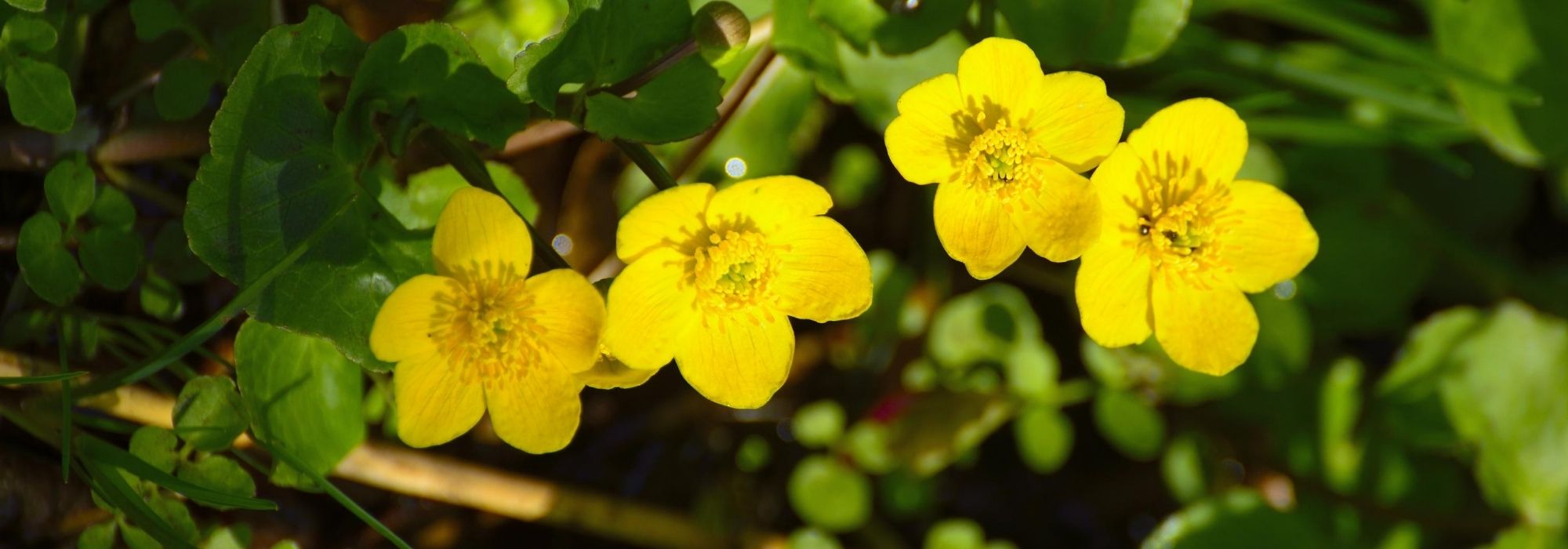
Marsh marigold, Caltha palustris: planting, growing, and care
Contents
Caltha in a nutshell
- Marsh marigolds are ideal young plants for ponds and natural marshes
- The spring flowering of Caltha is as astonishing as it is vibrant, reminiscent of large buttercup flowers
- The species most commonly encountered in cultivation is a native species: Caltha palustris
- Marsh marigolds or marsh buttercups should be planted in rich, consistently moist, even waterlogged soil.
- They are hardy perennials, free from pests and virtually disease-free
The word from our expert
The Caltha palustris is native to temperate regions of the North and is, therefore, perfectly hardy and resilient. In the wild, it is a semi-aquatic herbaceous perennial with rootstock found at the edges of water bodies, banks, or certain wet meadows. It will therefore be quite at home by a pond, a natural swimming pool, or even in a very damp part of your garden.
This perennial from the buttercup family offers us simple golden-yellow flowers in early spring, resembling buttercups, which are very useful for feeding the first spring pollinators. However, other varieties have been selected to provide us with white flowers or double flowers. Its glossy, deep green foliage consists of broad, thick deciduous leaves.
The marsh marigold prefers a rich soil that is necessarily moist or even waterlogged, but it can also be planted in an aquatic basket that can be submerged.
Equally at home in a very natural, even wild garden, as well as in a more contemporary or tidy style, the marsh marigold could make a triumphant return to our gardens.
Description and Botany
“`html
Botanical data
- Latin name Caltha sp. - Caltha palustris
- Family Ranunculaceae
- Common name Marsh marigold, Caltha of the marshes, Water buttercup
- Flowering March to June
- Height 15 to 70 cm
- Sun exposure sun
- Soil type clayey and always moist
- Hardiness -15°C
Caltha belong to the family Ranunculaceae and comprise around thirty species distributed across the Northern Hemisphere according to the latest botanical classifications. The most commonly encountered species include: Caltha palustris, Caltha natans, Caltha leptosepala, Caltha obtusa, and Caltha novae-zelandiae. Some older literature groups these plants under the genus name: Populago. The genus Caltha derives from the Greek word calathos, meaning basket, in reference to the shape of the flowers.
These plants thrive particularly in natural wet environments: along the edges of watercourses and bodies of water, in ditches, within marshes or swamps, or even in wet meadows.
Caltha are semi-aquatic perennials that form fairly compact clumps ranging from 15 to 70 cm in height depending on the species or varieties. Their root system consists of creeping rhizomes, allowing them to spread quickly if the environment suits them.
The foliage is deciduous, meaning it disappears in winter and only reappears in spring after flowering begins. The leaves are an elegant and fresh dark green, glossy on the upper side. They are heart-shaped, which means they have a cordate form, and are quite thick.
Flowers appear very early in the season, around March, which is beneficial for the first pollinators of the season. Flowering extends from March to June depending on the species or varieties. The flowers are hermaphroditic and resemble other flowers in the Ranunculaceae family like those of the buttercup (but larger!). They are regular flowers, apetalous, and have 5 petaloid tepals that are broadly ovate. Therefore, it is not the petals that are visible but the tepals. These tepals are yellow or white, single or double, and can reach a diameter of 4 cm. The flowers emerge atop upright stems rising 40 cm above the water.
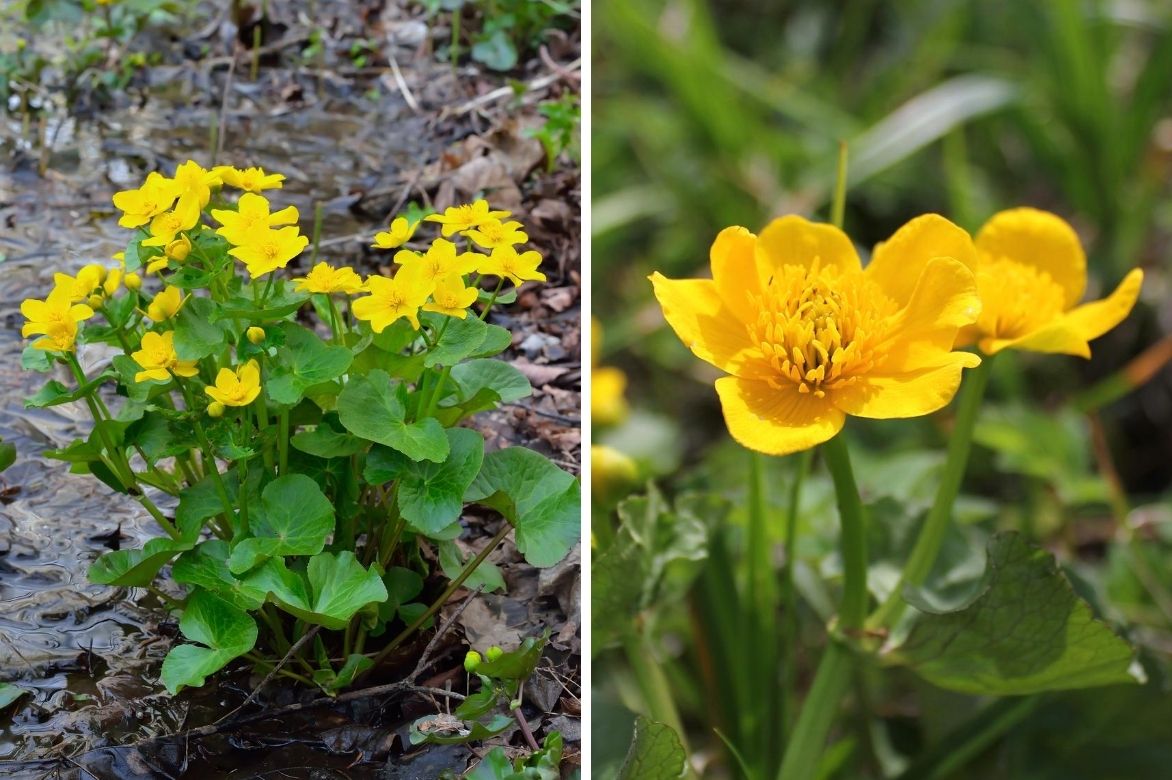 Marsh marigold: heart-shaped leaves and yellow flowers
Marsh marigold: heart-shaped leaves and yellow flowers
After fertilisation, the resulting seeds are designed to float on water thanks to feathery achenes. This characteristic allows them to quickly colonise other areas in nature.
Due to their geographical origins, Caltha are very hardy and trouble-free, thriving in any regularly waterlogged soil in full sun.
“`
The main species and varieties of Caltha
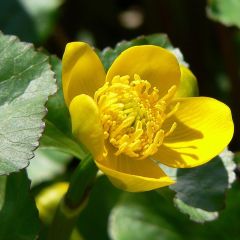
Caltha palustris Polypetala
- Flowering time May, June
- Height at maturity 40 cm
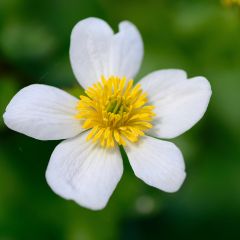
Caltha palustris var. alba
- Flowering time May, June
- Height at maturity 30 cm
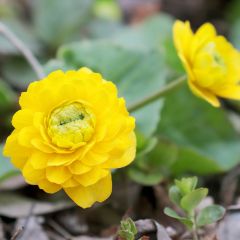
Caltha palustris Plena
- Flowering time May to July
- Height at maturity 30 cm
Discover other Caltha - Marsh Marigold
View all →Available in 1 sizes
Available in 1 sizes
Available in 1 sizes
Planting Calthas
Where to plant?
Caltha should be planted in full sun if possible, but partial shade in summer is tolerated. The soil must be deep, rich in humus, clayey, and cool, even completely wet. These perennials are indifferent to pH, but a neutral pH is preferred. If the soil is not sufficiently moist, the foliage will be less prominent, but the flowers will be larger.
When to plant?
Planting should take place in spring between April and June so that the root system can establish well throughout the summer of the first year. Planting in early autumn is possible: between late September and mid-October, but not later.
How to plant?
You have two options: in the ground or in a pot submerged in shallow water.
In the ground: plant your Caltha on the bank or at the water’s edge so that the water never covers the plant by more than 10 cm. Prepare a hole twice as wide as the root ball. A bit of compost will be welcome in the hole, and if your soil is too light, add some clay. Firm the soil around the plant with your hands. If the planting was done in water, do not touch it again. If the plant was placed on the bank, be sure to have a large watering can of water at planting.
In a pot: the easiest solution for immersing Marsh Marigold. Be sure to place the root ball in a basket designed for aquatic plants (available at garden centres in the “pond” section). The basket should be wide enough for the plant: at least 30 cm in diameter and about 20 cm deep. If your soil is clayey, use it to fill the basket; otherwise, use “aquatic plant” potting soil. Firm the root ball well in the basket and place some stones and gravel on top. The basket can be placed in the water at the edge of the water feature and submerged by 5 to 10 cm.
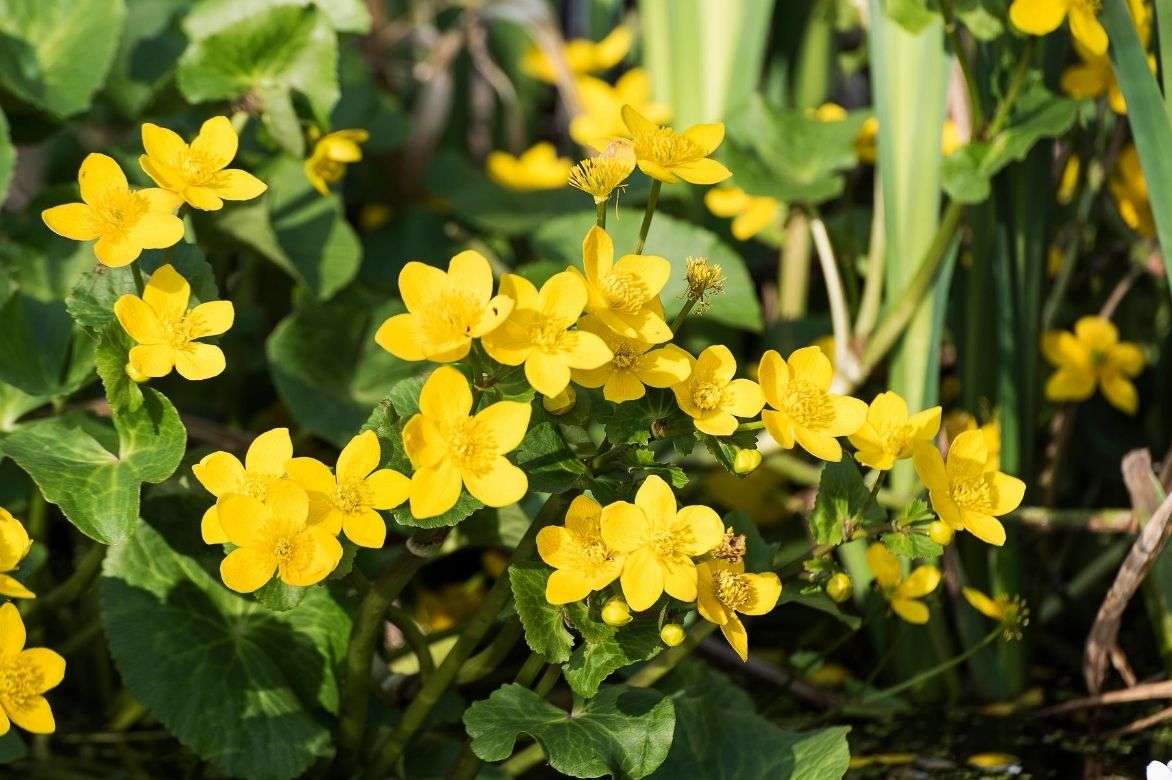
Read also
10 aquatic plants, submerged or floatingMaintenance and Care
Maintenance
Remember to cut off faded flowers as they appear during the flowering period; this will prevent the plant from self-seeding excessively and exhausting itself producing seeds. Additionally, removing faded flowers can sometimes lead to a resurgence of flowering in August.
When the foliage begins to yellow in autumn, remove it by cutting it back to the ground. This is a deciduous plant and will return in the following spring.
Occasionally, a bit of well-decomposed compost at the base of marginal and semi-aquatic plants will give them a little “boost“, but it is not essential if the soil is rich enough.
Nota bene: never use fertiliser in the water of a pond or water feature! This will have consequences for the wildlife living there, and furthermore, the nitrates formed will promote algae growth to the detriment of both fauna and flora. So, be cautious! However, some specific fertilisers exist in the form of small tablets to be buried in the soil of pots for certain aquatic plants, such as water lilies, but they are completely unnecessary for marsh marigolds…
Pests and Potential Diseases
Caltha is generally a very disease-resistant plant. However, some rust may appear in spring, as well as powdery mildew at the end of summer. The plant will be weakened but is unlikely to die.
For rust: simply removing the spotted leaves will be sufficient. A small decoction of horsetail diluted to 10% as a preventive treatment may, if necessary, be considered.
For powdery mildew: if the soil dries out around your Caltha but the nights are warm and humid, powdery mildew may appear. A light spray of a mixture consisting of 2 g of bicarbonate and 3 teaspoons of olive oil in one litre of water sprayed onto the foliage should suffice. In any case, although unsightly, this fungal “disease” is not harmful to the plant. It’s best to be patient and not intervene…
Propagation of Calthas
Division
Division is the simplest and quickest solution. Just after flowering in June, dig up the plant using a fork or retrieve the pot if it is grown in a container. Cut the stump with a sharp knife. These divisions should have well-developed roots and buds. Simply replant them elsewhere immediately or give them to your neighbours and friends. Finally, this is the only way to multiply double-flowered varieties.
Sowing
If the soil suits them, the marsh marigolds tend to self-seed naturally. Plants that are grown from seed take years to flower, unlike divisions which allow for flowering the following year.
Seeds should be sown at ripeness around September. Sow the seeds in fairly clayey soil and keep it constantly moist in partial shade. With a bit of luck and success, the seeds will germinate in March of the following year. If the plants are sturdy enough to handle, you can plant them immediately in their final location in spring. Otherwise, wait until autumn or even the following spring.
Beware! Sowing is not always true to type, and double-flowered varieties may revert to… single-flowered varieties.
Layering
Some Caltha, including Caltha palustris and particularly the variety ‘Polypetala’, layer naturally thanks to adventitious roots that form at the nodes. If this is the case, you can separate these layers, from the stems that have formed roots at a node, in autumn or around April and replant them elsewhere.
How to pair Calthas?
By the Edge of a Natural Pond
Marsh Marigold is a native plant that fits perfectly into a natural garden by the edge of a small pond teeming with wildlife. Let’s take a lovely Caltha palustris ‘Polypetala’ to adorn the banks. We can accompany it with a beautiful clump of Yellow Flag Iris, another native water’s edge plant whose yellow flowers will ensure continuity with the flowers of the Water Buttercup. Let’s continue with some “wildlings” for the rest of the bank, including a few Cirsium rivale ‘Frosted Magic’, two Lythrum salicaria, and a Hemp-Leaf Eupatorium that will attract many butterflies in summer. Closer to the water than these three, a Water Plantain, Alisma parviflora, will keep company with the Caltha at the water’s edge and serve as a perch for young dragonflies emerging from the water for other… more aerial adventures.
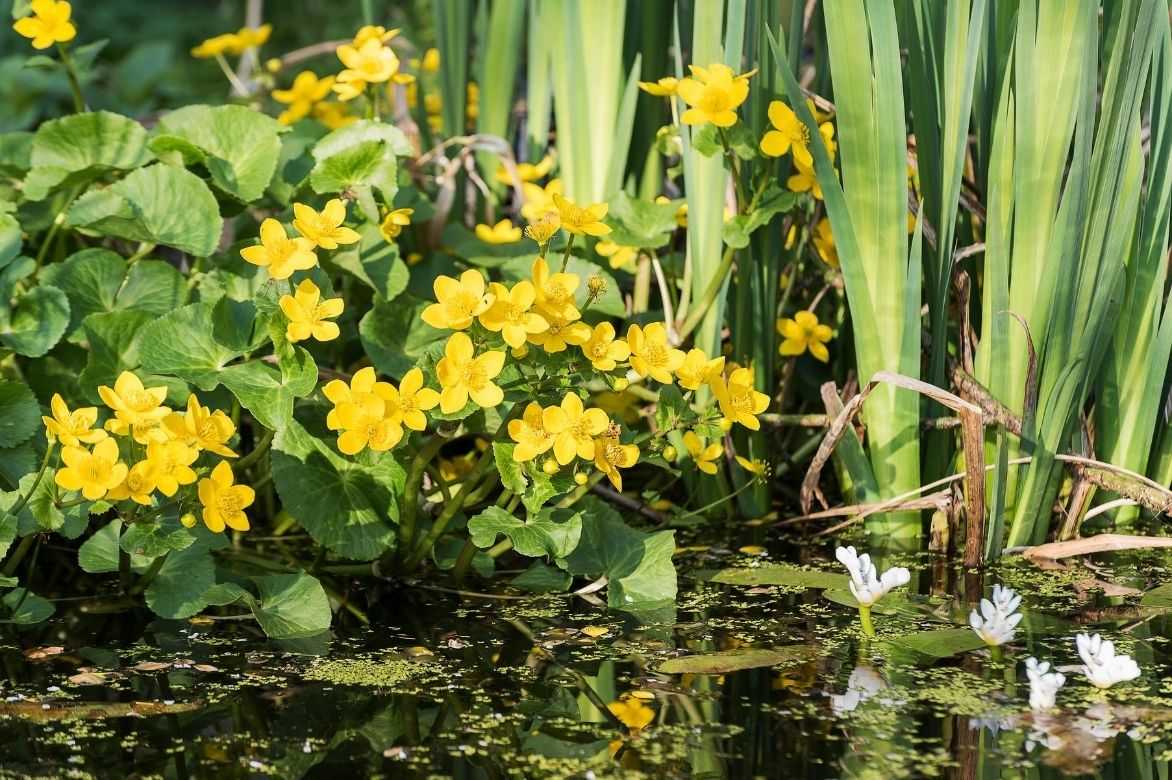
Marsh Marigold by the edge of a pond with Yellow Flag Iris and an Aponogeton distachyos
By the Edge of a Sophisticated Pool
Not all Caltha palustris have yellow flowers, as demonstrated by Caltha palustris var. alba, whose flower is white with a golden centre. To remind you of this golden centre, what could be better than foliage… golden. For this, the Virginia Spiderwort ‘Sweet Kate’ with golden foliage but particularly intense blue flowers will be wonderful in its company. To add a very graphic touch, a few clumps of Matteucia orientalis, ferns with feathery sterile fronds, will be perfect for the shadier side of the pool (they do grow well in the sun as long as the soil remains constantly moist). To break the monotony of the green ferns, we might consider some “vegetable candyfloss” like the simple yet always effective Filipendula palmata. Now that we have taken care of the edge of the pool, let’s plant a more aquatic plant! The Pontederia cordata ‘White Pike’, whose white flowers (Pontederias usually have blue flowers) will give a friendly nod to the white tepals of the white Marsh Marigold.
Did you know?
- All parts of the mature plant are toxic, as is the case for the vast majority of Ranunculaceae. They contain a molecule called proto-anemonin;
- Despite its toxicity, the young shoots and flower buds of Caltha palustris were once consumed pickled and in salads;
- The reduction of wetland areas due to drying out and the general eutrophication of these areas (and sometimes dystrophication) in Western Europe has led to a decline in Marsh Marigold, Caltha palustris (and other species dependent on wet environments). This is yet another reason to plant it in your garden!;
- Due to its early flowering in spring, Caltha is a perfect plant to help the first foragers feed.
Useful resources
To discover:
- All our Caltha palustris available in our online nursery
- Advice sheet: Choosing aquatic plants for a pond or basin
- Advice sheet: Pond: 10 aquatic plants, submerged or floating
- Advice sheet: 8 oxygenating aquatic plants for ponds or pools
- Subscribe!
- Contents
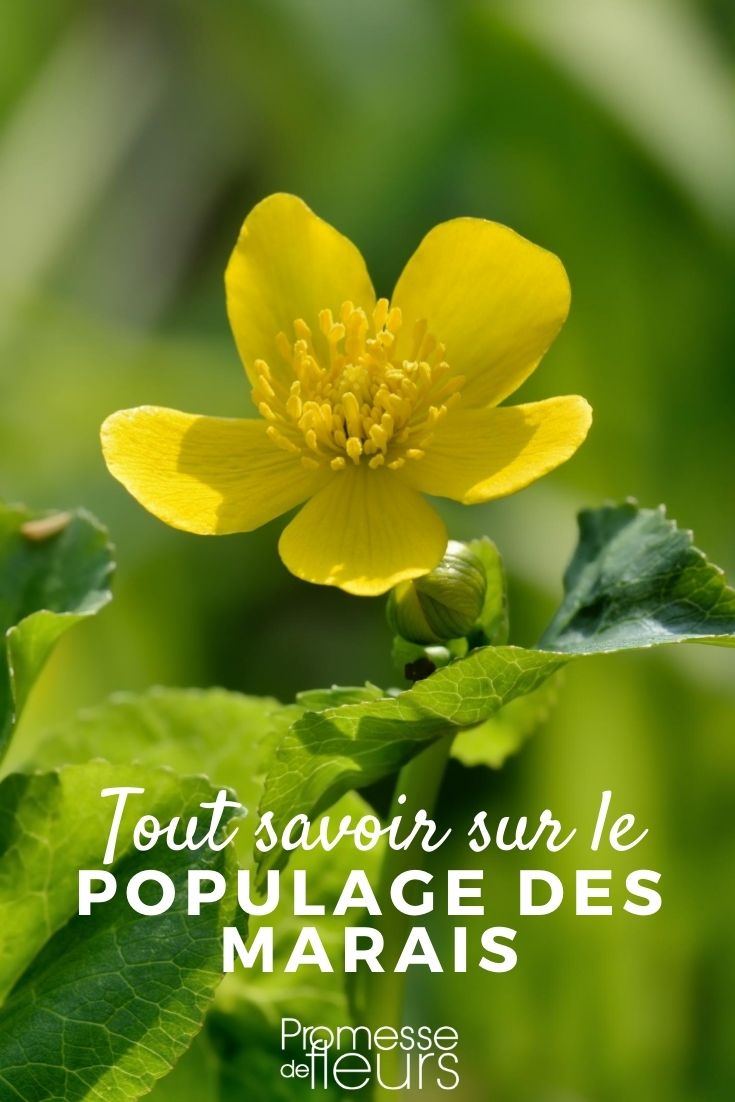


































Comments